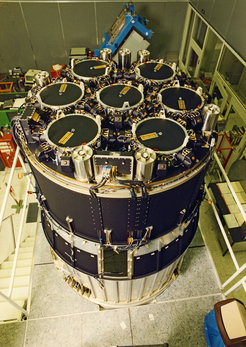CGRO celebrates 25th anniversary

The Compton Gamma Ray Observatory was the heaviest scientific payload ever put into orbit until then. MPE contributed two instruments: COMPTEL and EGRET.
For the 16-ton observatory, the MPE provided essential systems to two of the four instruments: the imaging Compton telescope COMPTEL for lower gamma energies and the Energetic Gamma Ray Experiment Telescope (EGRET) for the highest energies. The Compton Gamma Ray Observatory produced the first complete deep survey of the Universe in the full gamma ray range. Many new previously unknown sources were detected – about 270 by EGRET and about 40 by COMPTEL. Some sources were identified as pulsars and variable active galactic nuclei, but a large number remained unidentified.

The COMPTEL instrument was based on the double Compton effect, i.e it required two almost simultaneous interactions, resulting in a strong suppression of background noise. An incoming high-energy gamma-ray photon would scatter first with an electron in the forward detector module and again in a scintillator level on the rear. Both energies and the angle between the two scatterings were measured and from this a map with the source positions at various energies could be constructed. COMPTEL provided the first-ever all-sky continuum maps in the 1-30 MeV energy range and detected radioactivity in the Milky Way. In particular, it detected a gamma-ray line from the decay of an aluminium isotope – a clear sign from supernova explosions.

COMPTEL and EGRET detected many previously unknown gamma-ray sources.
EGRET was a spark-chamber instrument designed to cover the energy range from 20 MeV to about 30 GeV. It used a multilevel thin-plate spark-chamber system to detect gamma-rays by the electron-positron pair production process as well as a calorimeter using Nal(TI) to provide good energy resolution over a wide dynamic range. A highlight of science with EGRET is the discovery of blazars in the gamma-ray sky, a certain kind of quasars with a jet of relativistic particles shooting in the direction of the observer.
Almost a decade after its launch, the CGRO mission ended on 4 June 2000 with a forced re-entry of the satellite, after one of the three gyros on board had failed. But the legacy of CGRO is enormous. It not only achieved many "firsts", such as the all-sky map, it also laid the foundations for current gamma-ray satellite missions such as INTEGAL, Swift, and Fermi.














